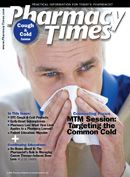OUTLOOK Obesity Epidemic
That’s What Friends Are For?
Parents often worry about the types of friends their children are keeping, in hopes that the youngsters will steer clear of those who might be a bad influence. A recent study has suggested that overweight children might have a higher potential to be negatively influenced than other groups when it comes to overeating, especially if those influencing them are also overweight.
For the study, 23 overweight and 42 normal weight children, aged 9 to 15, were randomized to be paired either with a friend or an unfamiliar person of similar age. The children did not eat for 2 hours prior to participating, and each rated their hunger before beginning. Each pair spent 45 minutes in a room stocked with games and puzzles, as well as both low-calorie, “nutrientdense” healthy snacks, and high-calorie, “energy-dense” snacks that included potato chips and cookies.
Participants were told to eat as much as they wanted, but only from their own bowls. By weighing the remaining snacks after the session, the researchers observed that friends eating together consumed more than those paired with strangers. Overweight children, whether paired with an overweight friend or stranger, ate more than their overweight counterparts who were paired with a normal weight individual.
The study was published in the American Journal of Clinical Nutrition (August 2009).
New Site Helps “Skinny Wishes” Come True While Helping Kids
With the overwhelming prevalence of weight-loss information online, it can be difficult for patients to weed out the worthless from the worthwhile. A new site recently launched by Brightgeist Media, www.skinnywishes.com, proves to be the latter by connecting patients with clinicians, including doctors and nutritionists, to help them reach their weight-loss goals.
Visitors to the bariatric and weightloss Web site are provided a life cycle “road map” to help guide them toward a healthier lifestyle. Comprising this are a physician directory and listings for weight-loss seminars in local regions, as well as an interactive community of doctors, nurses, and nutritionists who answer readers’ questions and share insight on obesity, weight-loss, and nutrition-related topics. Resources will be added over the coming months, including additional directories, weightloss programs and post maintenance solutions, a Spanish-language section, and customizable pages with userdefined content.
As part of the corporate mission of Skinny Wishes, a percentage of its doctor enlistment online fee will be donated to Louie’s Kids, a nonprofit organization that helps to treat childhood obesity on behalf of economically disadvantaged children throughout the country.
As Abdomen Swells, So Does Illness Risk
An expanding waistline equates to more than simply having to loosen one’s belt. Being abdominally obese carries with it an increased risk of developing type 2 diabetes, metabolic syndrome, and cardiovascular disease, according to the results of a recent study published in the Medical Journal of Australia (August 17, 2009).
The study surveyed 11,247 Australian adults aged 25 or over from 1999 to 2000. Of that group, 6537 returned for a follow-up examination in 2004 and 2005. The researchers found that obese participants had more than twice the likelihood of developing diabetes, high blood pressure, abnormal cholesterol levels, and metabolic syndrome over the next 5 years, compared with their counterparts with normal waist circumference. Notably, the risk of these conditions began to increase while the patient was still in the range of normal waist circumference. The study looked at 4 of the 5 top health risks linked to obesity, but did not examine the risks of other obesity-related conditions.
Rising Cost of Obesity
Most people look to trim down health care costs in any way possible, and for obese patients, losing the weight represents decreased numbers both on the scale and out of pocket. Health care spending for obese Americans aged 18 or older increased 82% between 2001 and 2006, expanding from $167 billion to $303 billion, according to the Agency for Healthcare Research and Quality, a component of the US Department of Health and Human Services. During the same timeframe, total spending on health care for overweight adults increased by 36%, from $202 billion to $275 billion. For adults of normal weight, costs rose 25%, from $208 billion to $260 billion.

